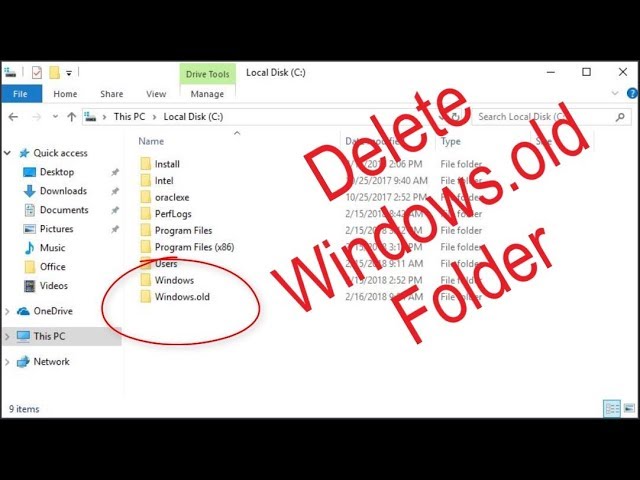Streamlining Your System: A Comprehensive Guide on How to Delete the Windows.old Folder in Windows 10

Introduction:
As Windows 10 evolves through updates and upgrades, a residual folder known as “Windows.old” often lingers on users’ systems, occupying valuable disk space. This folder contains the previous installation of Windows, including system files, program files, and user data. While it serves as a safety net for system recovery, it can consume a significant amount of storage. In this extensive guide, we will explore the step-by-step methods, considerations, and potential benefits of deleting the Windows.old folder in Windows 10.
Understanding the Windows.old Folder:
The Windows.old folder is automatically created during a major Windows 10 upgrade or reinstall. It safeguards essential files from the previous installation, providing users with a fallback option in case they encounter issues with the new version. While this feature is valuable for system recovery, it can occupy a substantial amount of disk space, especially for users with limited storage capacity.
Methods for Deleting the Windows.old Folder:
- Using Disk Cleanup:
- Disk Cleanup is a built-in utility in Windows 10 that facilitates the removal of unnecessary files, including the Windows.old folder. Follow these steps:
a. Press the “Windows key + S” to open the search bar. b. Type “Disk Cleanup” and select it from the search results. c. Choose the drive where Windows is installed (usually C:). d. Click “OK” to initiate the scanning process. e. Once the scan is complete, scroll down and check the “Previous Windows installation(s)” option. f. Click “OK” and then confirm the deletion by selecting “Delete Files.”
- Disk Cleanup is a built-in utility in Windows 10 that facilitates the removal of unnecessary files, including the Windows.old folder. Follow these steps:
- Using Storage Sense:
- Storage Sense is another native Windows 10 feature that automatically frees up disk space by removing unnecessary files. Follow these steps:
a. Open “Settings” by pressing the “Windows key + I.” b. Click on “System” and then select “Storage.” c. Toggle on “Storage Sense” to enable it. d. Click on “Configure Storage Sense or run it now.” e. Under “Free up space now,” check the “Delete previous versions of Windows” option. f. Click on “Clean now” to start the removal process.
- Storage Sense is another native Windows 10 feature that automatically frees up disk space by removing unnecessary files. Follow these steps:
- Manual Deletion:
- Users who prefer a more hands-on approach can manually delete the Windows.old folder. Follow these steps:
a. Open File Explorer and navigate to the drive where Windows is installed (usually C:). b. Right-click on the Windows.old folder and select “Delete.” c. If prompted for administrative permissions, confirm and proceed. d. Note that the system might prevent deletion of certain files within Windows.old. Skip those files or follow additional steps to take ownership and grant the necessary permissions.
- Users who prefer a more hands-on approach can manually delete the Windows.old folder. Follow these steps:
Considerations Before Deleting Windows.old:
- Data Backup:
- Before deleting the Windows.old folder, ensure that you have a recent backup of essential data. While the process is generally safe, unexpected issues can arise, and having a backup provides a safety net for your critical files.
- Recovery Options:
- Deleting the Windows.old folder eliminates the possibility of reverting to the previous Windows installation. Ensure that you are comfortable with the current version of Windows and that the system is stable before proceeding.
- System Restore Points:
- Confirm that you have reliable system restore points or backups in case you need to revert to a previous state. While deleting Windows.old is reversible through data recovery tools, having additional backups adds an extra layer of security.
- Disk Space Requirements:
- Assess your current disk space requirements before deleting Windows.old. If you have ample storage and no immediate need for the space occupied by Windows.old, you might choose to retain it temporarily.
Benefits of Deleting the Windows.old Folder:
- Freeing Up Disk Space:
- The primary benefit of deleting the Windows.old folder is the significant amount of disk space it reclaims. This is particularly advantageous for users with limited storage capacity on their devices.
- Improved System Performance:
- By freeing up disk space, users can experience improved system performance. This is especially noticeable on devices with solid-state drives (SSDs), where space optimization contributes to faster read and write speeds.
- Streamlined Storage Management:
- Deleting Windows.old allows for streamlined storage management. Users can efficiently allocate disk space for current applications, updates, and data, contributing to a more organized and responsive system.
- Reduced Clutter:
- Removing the Windows.old folder reduces clutter in the file system. Users can enjoy a cleaner and more organized directory structure without unnecessary remnants from previous Windows installations.
- Data Privacy and Security:
- Deleting the Windows.old folder enhances data privacy and security. It eliminates the risk of potential data exposure from the previous Windows installation, providing peace of mind for users concerned about privacy.
Conclusion:
Deleting the Windows.old folder in Windows 10 is a straightforward process that offers tangible benefits in terms of disk space reclamation, improved system performance, and streamlined storage management. By following the step-by-step methods outlined in this comprehensive guide and considering the associated considerations, users can confidently reclaim valuable storage space while ensuring the stability and security of their systems.
As Windows 10 continues to evolve with updates and enhancements, users have the tools at their disposal to optimize their computing experience. Deleting the Windows.old folder aligns with the principles of efficient storage management, allowing users to make the most of their devices and enjoy a responsive and clutter-free computing environment.




